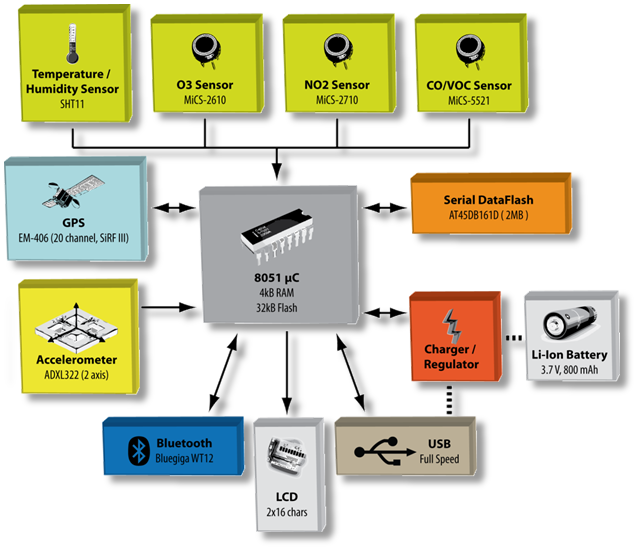Mobile Air Quality Monitoring Network
Air pollution is one of the most important factors affecting the quality of life and the health of the increasingly urban population of industrial societies. In the U.S., all major cities have networks of monitoring stations providing continuous measurements of the most important pollutants. However, the number of these stations is usually very small. Furthermore, currently the data of the different pollutants measured at the different stations in the city are aggregated to a single number, the air quality index (AQI), that is published once a day on a website. In other words, there is not enough data gathered to evaluate air quality in a given neighborhood and the publicly available information is even more deficient.
The Networked Embedded Systems Lab at ISIS created the Mobile Air Quality Monitoring Network (MAQUMON) that consists of a number of car-mounted sensor nodes measuring different pollutants in the air. The data points are tagged with location and time utilizing an on-board GPS. Periodically, the measurements are uploaded to a server, processed and then published on the Microsoft SensorMap portal. Given a sufficient number of nodes and diverse mobility patterns, a detailed picture of the air quality in a large area will be obtained at a low cost.
The sensor platform supports autonomous data collection, storage and off-line data retrieval or the streaming of live sensor readings. An integrated Bluetooth module provides a wireless interface for laptop computers or PDAs. Below is the architecture of the sensor node:

Alternatively, the system can be accessed through a USB cable. This wired interface can also provide power to the board both for on-line operation and for charging the integrated Li-ion battery. The battery life of the device is limited to a few hours (in active data acquisition mode), but in the car mounted scenario, it can be constantly powered from the cigarette lighter. Furthermore, a 2-axis MEMS accelerometer is used to detect if the system is in motion and can automatically turn off all the power hungry components (GPS, Bluetooth, gas sensors) if not in use. Location and time information is provided by an on-board 20 channel SiRF-III-based GPS module at 1 Hz sampling rate. Gas concentration levels are measured by three analog sensors: O3, NO2 and CO/VOC. These readings along with temperature and relative humidity data and GPS information are stored in a serial flash device 2MB. A 2x16 character LCD panel provides immediate visual feedback about the status of the system (connected interfaces, GPS lock, time, motion detection, sensor readings). The Intel 8051-based microcontroller controls every aspect of the system from battery charging to analog/digital conversions and the USB protocol.
A photograph of the prototype board in its enclosure is shown below.

Sensor mobility is handled using the SensorMap mobile proxy feature. Overall air quality will be displayed in the form of contour maps utilizing image overlays. The time series data for a given sensor and/or a given geographic location will be also available. The figure below illustrates the visualization techniques employed by the MAQUMON system.

Visit the NEST page for information on our other projects. This project was made possible by a generous gift from Microsoft Research.